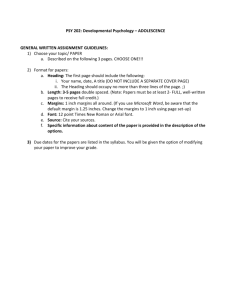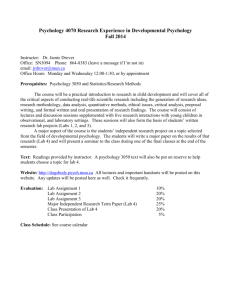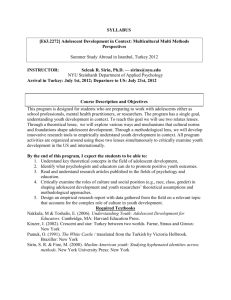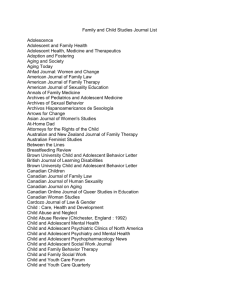Psychology 352
advertisement
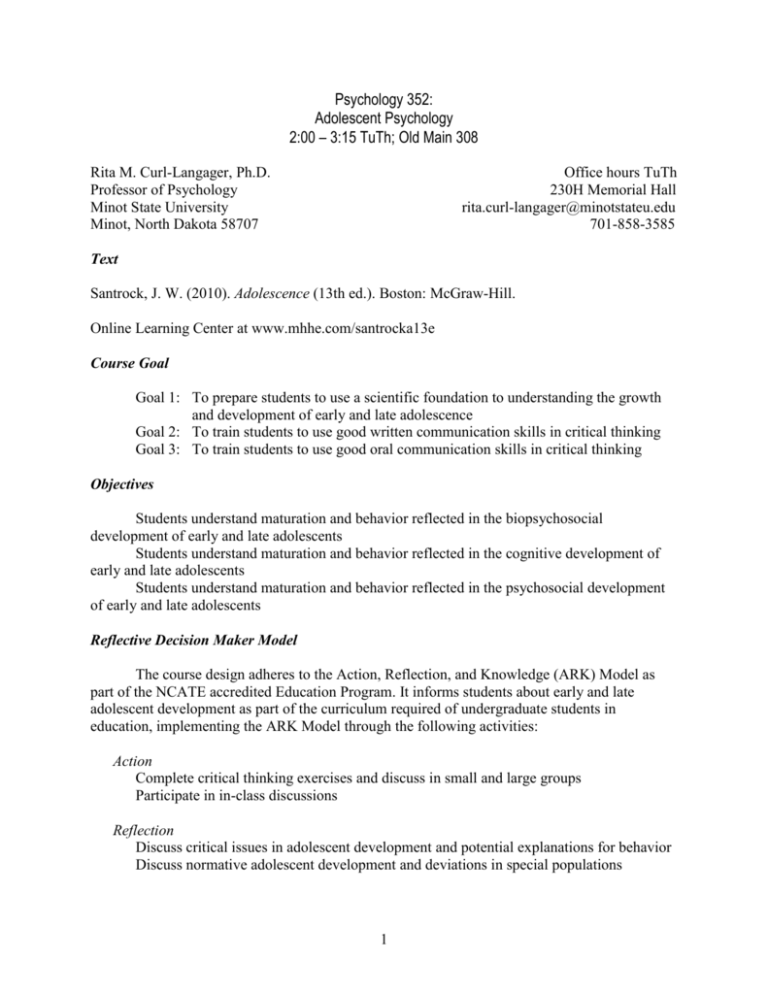
Psychology 352: Adolescent Psychology 2:00 – 3:15 TuTh; Old Main 308 Rita M. Curl-Langager, Ph.D. Professor of Psychology Minot State University Minot, North Dakota 58707 Office hours TuTh 230H Memorial Hall rita.curl-langager@minotstateu.edu 701-858-3585 Text Santrock, J. W. (2010). Adolescence (13th ed.). Boston: McGraw-Hill. Online Learning Center at www.mhhe.com/santrocka13e Course Goal Goal 1: To prepare students to use a scientific foundation to understanding the growth and development of early and late adolescence Goal 2: To train students to use good written communication skills in critical thinking Goal 3: To train students to use good oral communication skills in critical thinking Objectives Students understand maturation and behavior reflected in the biopsychosocial development of early and late adolescents Students understand maturation and behavior reflected in the cognitive development of early and late adolescents Students understand maturation and behavior reflected in the psychosocial development of early and late adolescents Reflective Decision Maker Model The course design adheres to the Action, Reflection, and Knowledge (ARK) Model as part of the NCATE accredited Education Program. It informs students about early and late adolescent development as part of the curriculum required of undergraduate students in education, implementing the ARK Model through the following activities: Action Complete critical thinking exercises and discuss in small and large groups Participate in in-class discussions Reflection Discuss critical issues in adolescent development and potential explanations for behavior Discuss normative adolescent development and deviations in special populations 1 Psychology 352 Spring 2010 Knowledge Demonstrate detailed knowledge of child development by successfully completing four written exams over Adolescence: An Introduction (12th ed.) Tests Four tests will be given throughout the semester. @ 100—150 points Critical Thinking Exercises One set of critical thinking exercises accompanies each chapter. Write an explanation for each alternative provided after the final statement or question in each exercise. You will participate in small groups to discuss the questions and your answers before we discuss each one as a class. You must submit your written explanations to me by 5:00 p.m. the day we complete our discussion of the chapter. The 13 chapter exercises are valued at 10 points each. 130 total points Timeline 1/12 Introductions and Overview of Course 14 Chapter 1-Introduction 1/19 " 21 Chapter 2-Puberty, Health, and Biological Foundations 1/26 " 28 Chapter 3-The Brain and Cognitive Development 2/ 2 " 4 " 2/ 9 Test 1-Chapters 1 - 3 11 Chapter 4-The Self, Identity, Emotions, and Personality 2/16 " 18 Chapter 5-Gender 2/23 " 25 Chapter 6-Sexuality 3/ 2 " 4 Chapter 7-Moral Development, Values, and Religion 3/ 9 " 11 Test 2-Chapters 4 - 7 3/15-19 Spring Break 3/23 Chapter 8-Families 25 " 3/30 Chapter 9-Peers, Romantic Relationships, and Lifestyles 4/ 1 " 4/ 6 Chapter 10-Schools 8 " 4/13 Test 3-Chapters 8 - 10 15 Chapter 11-Achievement, Work, and Careers 2 Psychology 352 4/20 22 4/27 29 5/ 4 6 5/11 Spring 2010 Achievement, Work, and Careers, cont. Chapter 12-Culture " Chapter 13-Problems in Adolescence and Emerging Adulthood " Review Test 4-Comprehensive--Chapters 1 - 13 Tuesday, May 11 from 2:00 to 3:50 Grading Tests 450 points Critical Thinking Exercises - 10 X 13 = 130 points Class Discussion 40 points Final Grade A 90% and above (based on top scores) B 80% - 89.9% C 70% - 79.9% D 60% - 69.9% F 59.9% and below 3 Psychology 352 Spring 2010 Assumptions, Inferences, and Observations Class Exercises for Psychology 352: Adolescent Development An assumption is “something taken for granted, a supposition” (Random House Dictionary, 1987). Assumptions are guiding beliefs, values, or convictions that motivate or structure a presentation in the book. They are points the author implicitly or explicitly takes for granted and attempts neither to document nor to defend with reasons. A theoretical assumption has practical consequences requiring researchers to create instruments to measure theoretical constructs. Assumptions usually appear (or are implied) early in an argument and, therefore, appear early in the relevant passage. Key thought: Authors often place assumptions early in the passage or paragraph. An inference as it relates to logic is “(a) a process of deriving the strict logical consequences of assumed premises; (b) the process of arriving at some conclusion that, though it is not logically derivable from the assumed premises, possesses some degree of probability related to the premises” (Random House Dictionary, 1987). Inferences are reasoned guesses, predictions, explanations, or conclusions. They typically are interpretations or extrapolations from assumptions or observations. Authors provide a clue that a statement is an inference by using words such as “may,” “might,” or “because,” especially when they present hypotheses or explanations. Key thought: Inferences are associated with beliefs or hypotheses. An observation is “an act or instance of viewing or noting a fact or occurrence for some scientific or other special purpose” (Random House Dictionary, 1987). Observations are research findings stated in terms of the specific information researchers gather. They typically describe conditions, associations in data, or respondents’ performances. Observations are statements about “the way things are” in terms of information that researchers have gathered about them. Key thought: Authors present observations along with data and referenced research. Your reasoning to support each decision is a very important part of each exercise. Random House Dictionary of the English Language (2nd ed.) Unabridged. New York: Random House, Inc. 4


